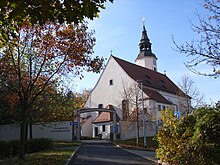King hooves
|
King hooves
City of Goerlitz
|
|
|---|---|
| Coordinates: 51 ° 10 ′ 0 ″ N , 14 ° 58 ′ 46 ″ E | |
| Height : | about 220 m above sea level NN |
| Area : | 4.7 km² |
| Residents : | 8028 (December 31, 2011) |
| Population density : | 1,708 inhabitants / km² |
| Postal code : | 02828 |
| Area code : | 03581 |
|
Location of Königshufen in Görlitz
|
|
Until the incorporation of Klingewald, Königshufen was the northernmost district of Görlitz and is therefore often referred to colloquially as "North".
history
The name Königshufen is a name for a unit of area , which in this case covers 180 acres . The so-called eight Königshufen , these were eight corridor plots north of Heiligen-Grab-Strasse, also encompass today's area of the district. The eight Königshufen reached from today's Nieskyer Strasse down to the Neisse. The first four royal hooves are labeled with the Roman numerals I to IV on the map in the picture. They each cover between 47.6 and 48.6 hectares with a plot width between 230 and 260 meters. A special feature of these former arable land is that the associated farm yard was not always on the property. The first Königshufe belonged to the Jäkelschen Vorwerk (once Heilige-Grab-Straße 60/61), the second to the Vorwerk am Jugendbrunnen (once Heilige-Grab-Straße 42), the third to Schuster's Vorwerk (once Heilige-Grab-Straße 58 / 59) and the fourth to the Vorwerk am Kirchhofe .
The Königshufen settlement, consisting of houses with front gardens, was built in 1939. During the GDR era , the district was supplemented by a new building area consisting mainly of prefabricated buildings , which at the time of its construction was way ahead of the other residential areas in Görlitz. While many of the buildings in Görlitz's old town were degenerating, several new prefabricated districts were built on the outskirts, first in Weinhübel on the southern periphery, later stepped up on the northern periphery, where between 1978 and 1987 around 6000 prefabricated apartments and supply facilities were built in Königshufen. The panel construction type WBS 70 was mainly used . Advantages in addition to the central heating and running water were the low rents of e.g. B. 60 marks for a two-room apartment of around 60 m².
More and more blocks were added in the mid-1980s and Königshufen became one of the most densely populated districts of Görlitz. Due to the existing demand, several crèches, kindergartens and playgrounds were set up. 1986 Königshufen got a connection to the Görlitz tram network .
After 1989, due to rising unemployment, there was a strong emigration of residents from Görlitz and in particular from the now less attractive new building districts. Formerly overcrowded kindergartens and schools had to close over time due to a lack of children.
Königshufen today
The district is to be redesigned as part of a district redevelopment. In addition to optically attractive designed prefabricated buildings, single and multi-family houses are to be built. Some of the old prefabricated buildings have already been demolished to make way for large-scale green spaces. Some of the prefabricated buildings will also have elevators to make them attractive again for older residents. Due to renovated living space in the inner and old town and a project by the city of Görlitz, which is intended to encourage residents to move to the inner city, there is a population decline in Königshufen. The conversion of the Scultetus-Mittelschule on the boulevard into a handicapped-accessible all-day school or the G 22 physically handicapped residential community not far from the Königshufen estate should be positively mentioned .
A large commercial area borders the district with many shopping opportunities and services. The Kö-Passage is centrally located.
Attractions
- Old and new cemetery
- Hope Church : the church, consecrated in 1998, was originally located in Deutsch-Ossig , where it had to give way to open -cast lignite mining in 1988, was demolished and rebuilt in Königshufen using original components.
traffic
Public transport of the Görlitzer Verkehrsbetriebe :
- Tram line 1 (to Weinhübel )
- Tram line 2 (to Landeskrone )
- Call bus line C (to Demianiplatz)
With the timetable change in mid-2008, the evening bus service to Rauschwalde and the "Schlenker" bus route C from Klingewalde via Königshufen to the city center were discontinued.
The federal highway 6 touches the northern part of the city and connects to the north with the federal highway 115 and federal highway 99 to the highway entrance "Görlitz". The federal road 99 leads to the south, into the center of Görlitz or in the southeast of the district of Görlitz .
Individual evidence
- ↑ goerlitz.de: Statistical monthly figures for the city of Görlitz, December 2011 . (No longer available online.) Archived from the original on October 18, 2012 ; Retrieved June 11, 2012 . Info: The archive link was inserted automatically and has not yet been checked. Please check the original and archive link according to the instructions and then remove this notice.
- ^ Jecht, Richard: History of the City of Görlitz, Volume 1, Half Volume 2 . 1st edition. Verlag des Magistrates der Stadt Görlitz, 1934, p. 579 .







